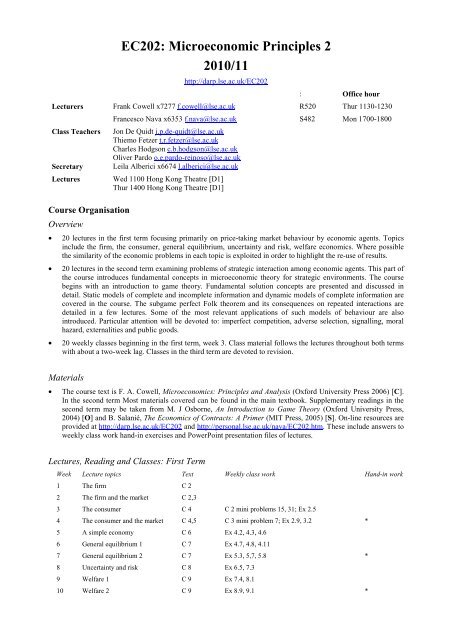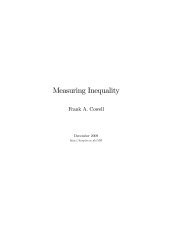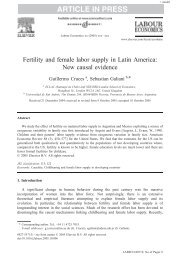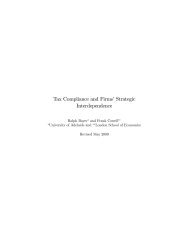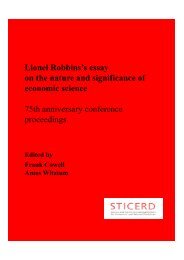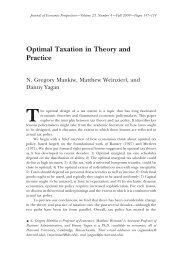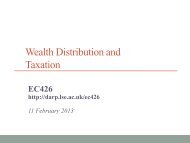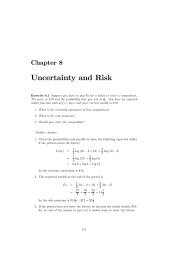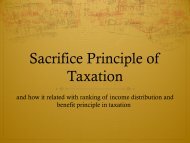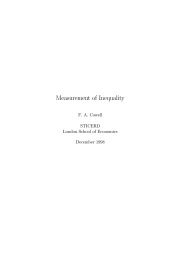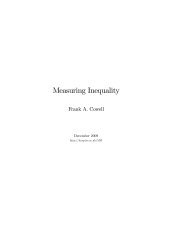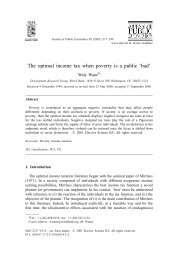EC202: Microeconomic Principles 2 2010/11 - DARP
EC202: Microeconomic Principles 2 2010/11 - DARP
EC202: Microeconomic Principles 2 2010/11 - DARP
Create successful ePaper yourself
Turn your PDF publications into a flip-book with our unique Google optimized e-Paper software.
Lecturers<br />
Class Teachers<br />
Secretary<br />
Lectures<br />
<strong>EC202</strong>: <strong>Microeconomic</strong> <strong>Principles</strong> 2<br />
<strong>2010</strong>/<strong>11</strong><br />
http://darp.lse.ac.uk/<strong>EC202</strong><br />
Frank Cowell x7277 f.cowell@lse.ac.uk<br />
Francesco Nava x6353 f.nava@lse.ac.uk<br />
Jon De Quidt j.p.de-quidt@lse.ac.uk<br />
Thiemo Fetzer t.r.fetzer@lse.ac.uk<br />
Charles Hodgson c.b.hodgson@lse.ac.uk<br />
Oliver Pardo o.e.pardo-reinoso@lse.ac.uk<br />
Leila Alberici x6674 l.alberici@lse.ac.uk<br />
Wed <strong>11</strong>00 Hong Kong Theatre [D1]<br />
Thur 1400 Hong Kong Theatre [D1]<br />
: Office hour<br />
R520<br />
S482<br />
Thur <strong>11</strong>30-1230<br />
Mon 1700-1800<br />
Course Organisation<br />
Overview<br />
• 20 lectures in the first term focusing primarily on price-taking market behaviour by economic agents. Topics<br />
include the firm, the consumer, general equilibrium, uncertainty and risk, welfare economics. Where possible<br />
the similarity of the economic problems in each topic is exploited in order to highlight the re-use of results.<br />
• 20 lectures in the second term examining problems of strategic interaction among economic agents. This part of<br />
the course introduces fundamental concepts in microeconomic theory for strategic environments. The course<br />
begins with an introduction to game theory. Fundamental solution concepts are presented and discussed in<br />
detail. Static models of complete and incomplete information and dynamic models of complete information are<br />
covered in the course. The subgame perfect Folk theorem and its consequences on repeated interactions are<br />
detailed in a few lectures. Some of the most relevant applications of such models of behaviour are also<br />
introduced. Particular attention will be devoted to: imperfect competition, adverse selection, signalling, moral<br />
hazard, externalities and public goods.<br />
• 20 weekly classes beginning in the first term, week 3. Class material follows the lectures throughout both terms<br />
with about a two-week lag. Classes in the third term are devoted to revision.<br />
Materials<br />
• The course text is F. A. Cowell, <strong>Microeconomic</strong>s: <strong>Principles</strong> and Analysis (Oxford University Press 2006) [C].<br />
In the second term Most materials covered can be found in the main textbook. Supplementary readings in the<br />
second term may be taken from M. J Osborne, An Introduction to Game Theory (Oxford University Press,<br />
2004) [O] and B. Salanié, The Economics of Contracts: A Primer (MIT Press, 2005) [S]. On-line resources are<br />
provided at http://darp.lse.ac.uk/<strong>EC202</strong> and http://personal.lse.ac.uk/nava/<strong>EC202</strong>.htm. These include answers to<br />
weekly class work hand-in exercises and PowerPoint presentation files of lectures.<br />
Lectures, Reading and Classes: First Term<br />
Week Lecture topics Text Weekly class work Hand-in work<br />
1 The firm C 2<br />
2 The firm and the market C 2,3<br />
3 The consumer C 4 C 2 mini problems 15, 31; Ex 2.5<br />
4 The consumer and the market C 4,5 C 3 mini problem 7; Ex 2.9, 3.2 *<br />
5 A simple economy C 6 Ex 4.2, 4.3, 4.6<br />
6 General equilibrium 1 C 7 Ex 4.7, 4.8, 4.<strong>11</strong><br />
7 General equilibrium 2 C 7 Ex 5.3, 5,7, 5.8 *<br />
8 Uncertainty and risk C 8 Ex 6.5, 7.3<br />
9 Welfare 1 C 9 Ex 7.4, 8.1<br />
10 Welfare 2 C 9 Ex 8.9, 9.1 *
Lectures, Reading and Classes: Second Term<br />
Week Lecture topics Text Supplementary Weekly class work Hand-in<br />
1 Game Theory: Strategic Form Games<br />
Dominance and Pure Strategy Nash Equilibrium<br />
2 Mixed Strategy Equilibria<br />
Duopoly<br />
3 Incomplete Information Games<br />
Bayes Nash Equilibrium<br />
C10.2, C10.3.1-4<br />
O2.1, O2.6,<br />
O2.8-9<br />
C10.3.5, C10.4 O4.1-4, O3.1-2 9.6<br />
9.2 , 9.3, 9.5<br />
C10.7 O9.1-3 10.1,10.2, 10.3<br />
4 Extensive Form Games and Dynamics C10.5 O5.1-4 10.4, 10.7.1-3,<br />
10.17, O282.1<br />
5 Imperfect Competition<br />
Repeated Games<br />
6 Folk Theorem<br />
Adverse Selection: Monopoly<br />
C10.5-6 O14, O15.1-2 10.7.4-5, 10.12,<br />
O183.1-2<br />
C10.5, C<strong>11</strong>.2 S2 10.13, 10.15.1-2<br />
7 Adverse Selection: Competition C<strong>11</strong>.2 S3.1.3, S3.2.1 O442.1, O429.1,<br />
10.15.3, 10.16<br />
8 Signalling C<strong>11</strong>.3 S4, O10.5-6 <strong>11</strong>.1, <strong>11</strong>.2<br />
9 Moral Hazard C<strong>11</strong>.4 S5.1- 5.3.5 <strong>11</strong>.5, <strong>11</strong>.6<br />
10 Externalities & Public Goods C13.4, C13.6.1-4 O2.8.4, 9.5 <strong>11</strong>.8 13.5, 13.6 *<br />
*<br />
*<br />
Course Requirements<br />
Classwork<br />
Classes begin in the third week of the first term and continue into the third term.<br />
• The work for each week consists of one or more exercises taken from the textbook and some of the “mini<br />
problems” in the text chapters – see the schedule above. Answers to exercises will be posted on the website<br />
throughout the year. You are expected to make a reasonable attempt at the classwork in advance of the class.<br />
• You should also try to solve the other mini problems since they are designed to help you complete some of the<br />
steps involved in the reasoning. Answers to the mini-problems are in Appendix B of the text.<br />
• In weeks 4, 7 and 10 of each term written assignments are required: these assignments will be of the same scope<br />
and difficulty as exam questions. You are expected to be diligent about meeting the deadlines for submission.<br />
• Even though group work is encouraged on weekly assignments, we recommend that you do not discuss hand-in<br />
problem sets with your peers prior to submission. Graded problem sets are meant to assess your individual<br />
progress on the materials throughout the year and it is in your best interest to have such information to fill in<br />
possible gaps.<br />
Examination<br />
There will be a single three-hour, four-question paper. The 2006-<strong>2010</strong> papers (available in the Library) can be used<br />
as general guidance to the style and level of difficulty. The 20<strong>11</strong> paper will follow the format of the <strong>2010</strong> paper with<br />
the exception that in 20<strong>11</strong> there will be only three questions in section B and three questions in section C . The<br />
principal features are:<br />
• Question 1 (the compulsory question) is worth 40% of total marks.<br />
• Question 1 requires candidates to answer 5 out of 8 parts.<br />
• The three other questions are worth 20% each.<br />
2


